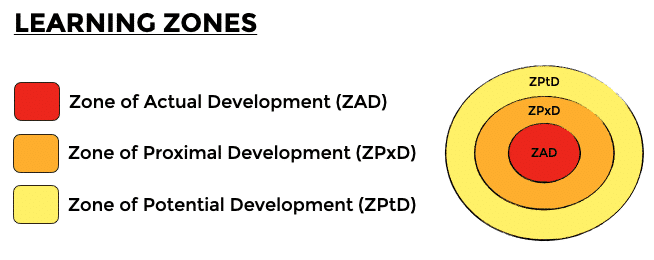The teaching process in football goes beyond imparting knowledge, it involves understanding the sensitive phases of players and tapping into areas of development to maximise their potential.
In this journey, we dive into the ideas of prominent authors, such as Weineck and Vygotsky, to shed light on the development of a holistic education.
Weineck (1988) reminds us of the importance of respecting players’ sensitive phases, periods conducive to meaningful learning. Connecting with these crucial moments, it is essential to reach optimal levels of cognitive and motor development.
Considering the ludological stages, which reflect the level of understanding of the game, guides us in the selection of skills to develop at each stage.
Following this line, Vygotsky (1979) introduces the Theory of Developmental Zones, breaking it down into Zone of Actual Development (ZAD), Zone of Proximal Development (ZPxD) and Zone of Potential Development (ZPtD).
These zones become essential tools for planning and adapting the teaching process.
Zone of Actual Development (ZAD):
This zone represents a player’s ability to solve problems independently. For example, a player can control the ball efficiently, indicating that this skill is in the ZAD. The choice of training content and concepts should start from this zone, consolidating already mastered skills and building knowledge.
Zone of Proximal Development (ZPxD):
The ZPxD encompasses the learning that a player can achieve with the help of teammates and coaches, surpassing what he or she could achieve independently. Here, external intervention becomes the catalyst for development, enabling the construction and modification of knowledge schemas. Dynamic interaction in this zone is fundamental to progress.
Zone of Potential Development (ZPtD):
The ZPtD reflects the distance between what a player can solve individually and what he/she can achieve with the help of others, especially after working on the ZPxD. Skills that are initially in the ZPtD move to the ZPxD once they are consolidated and optimised. Here, the coach plays a crucial role in creating situations that demand effort and understanding, leading players towards their full potential.
In summary, the teaching methodology in football, according to Chaves (2001), should focus on what the player already possesses or performs, as well as on the behaviours he/she has not yet mastered, fostering the emergence of new skills in the ZPtD.
The coach, playing the roles of observer, mediator and creative, becomes the key figure in guiding players towards their zone of potential development.
This instruction requires a deep understanding of the developmental zones, highlighting the importance of respecting sensitive phases, selecting skills based on the ZAD and using the ZPxD as a dynamic space of interaction.
The active role of the coach, by being aware and demanding, guides players to explore their ZPtD and build a solid and lasting football knowledge, thus transcending the playing field and becoming a journey of discovery and individual growth for each player.







